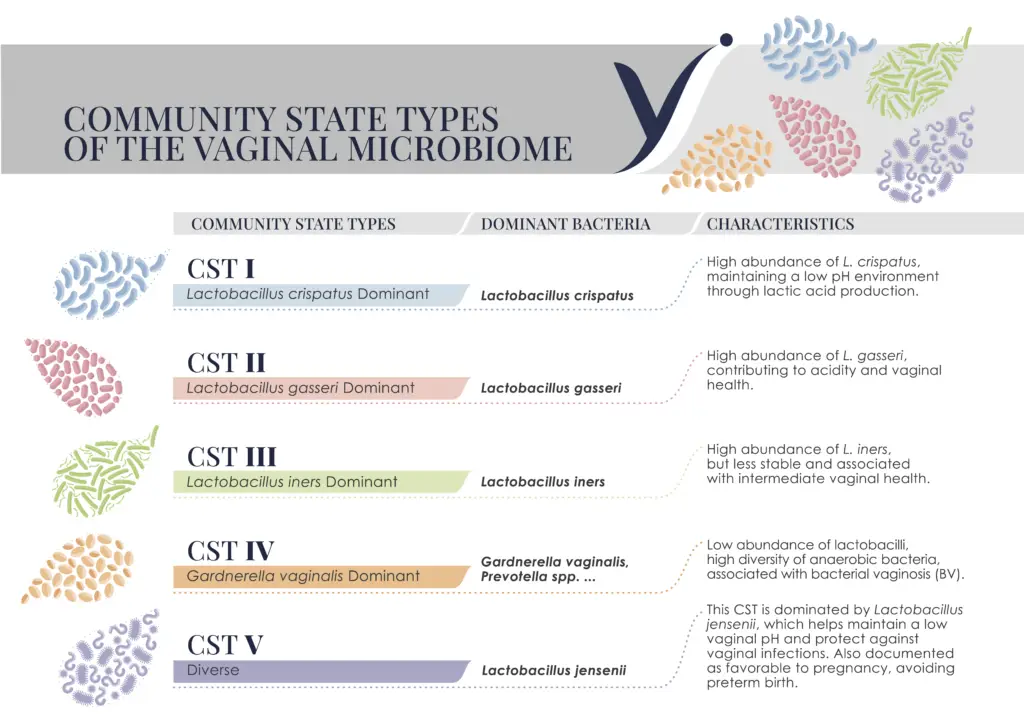What is the vaginal flora?
The vaginal flora, synonym of vaginal microbiome, is a collection of bacteria and other microorganisms living in a woman’s vagina. Think of it like a tiny community working together to keep the vagina healthy. This community helps prevent infections like bacterial vaginosis (BV) and yeast infections.
The most important members of this community are a group of bacteria called lactobacilli. These bacteria make substances, like lactic acid, which keep the vagina slightly acidic. This acidity is important because it stops harmful bacteria from growing and causing infections.
In simple terms, the healthy vaginal microbiome is a natural shield that keeps the vagina healthy by creating an environment that is tough for harmful germs to thrive in, and this is very good for preventing infections.
Most important communities present in the vaginal microbiome divided in groups called Community State Types:

How does the microbiota develop, establish and evolve throughout our lives?
At birth, the mode of delivery—whether vaginal delivery or cesarean—can impact the initial colonization of the infant’s microbiome.
Breastfeeding: Breast milk helps develop a healthy gut bacteria community in babies, which is important for overall health.
Growing Up: As we grow, our lifestyle and what we eat affect our vaginal microbiome. Eating foods high in fibers (which feed good bacteria), and fermented foods (like yogurt) helps good bacteria thrive.
Diet: A diet full of sugar and processed foods can upset the balance of bacteria, leading to problems like infections.
In summary, the microbiome starts developing at birth and continues to change based on diet and lifestyle. Eating healthy foods helps maintain a good balance of bacteria, which is crucial for preventing infections and staying healthy.
Do probiotics help your vaginal flora / microbiome?
Probiotics, specifically strains of lactobacilli, (the frequent bacteria that we find in the vaginal microbiome, remember?) are often recommended to restore and maintain a healthy vaginal flora. These probiotics can be taken orally or applied vaginally in the form of supplements, capsules, or creams (please refer to the usage instructions of your probiotic to see the correct method of use). By reintroducing beneficial bacteria, probiotics may help rebalance the microbiome and reduce the risk of recurrent infections.
How to take care of your intimate hygene
Hygiene practices also influence the vaginal microbiome. While maintaining good hygiene is essential, excessive use of harsh soaps, douches, or vaginal deodorants can disturb the natural pH and microbial balance of the vagina, predisposing it to infections.Opt for neutral soap, coconut soap, and wash only externally, in the vulva area. Completely remove the soap with water, ensuring no soap residue is left between the labia in the intimate area.
Can you test your vaginal microbiome?
Regular screening and testing of the vaginal microbiome can provide valuable insights into its composition, which community state types the woman is closer to, and help guide personalized interventions for optimizing vaginal health. While self-testing kits are available, consulting a healthcare professional for comprehensive evaluation and management is advisable, especially in cases of persistent symptoms or recurrent infections.